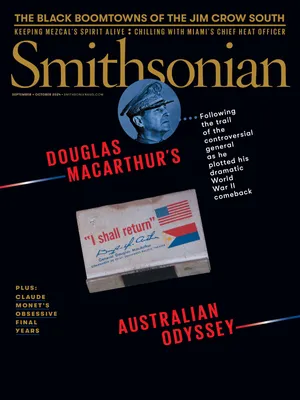:focal(1050x750:1051x751)/https://tf-cmsv2-smithsonianmag-media.s3.amazonaws.com/filer_public/76/d6/76d67b3a-194d-4272-8a84-afd131abd21a/untitled-1.jpg)
An 1851 ink-and-watercolor gift drawing titled A Type of Mother Hannah’s Pocket Handkerchief by Polly Jane Reed, a Shaker in New Lebanon, New York.
Andrews Collection, Hancock Shaker Village, Massachusetts
In the 18th century, a singular religious society arrived on American shores from England. Its members were known as Shakers, from their tendency to “shake” off evil during fervent worship. The Shakers lived in communal households devoid of decor. But as a new exhibition of ornate drawings illustrates, they weren’t bound by simplicity. Shaker women made and exchanged—but never displayed—these “token” drawings, which often depicted natural motifs like a “Tree of Life” or flowery garden.
The Tree of Life, Hannah Cohoon, ink and watercolor on paper, 1854. Andrews Collection, Hancock Shaker Village, Massachusetts/https://tf-cmsv2-smithsonianmag-media.s3.amazonaws.com/filer_public/63/40/6340a114-66bd-48a8-99ab-c58796cd2051/sepoct2024_l27_prologue.jpg)
The art conveys a “creative vibrancy” that changes perceptions of Shaker culture, says Emelie Gevalt, the coordinating curator of “Anything but Simple: Gift Drawings and the Shaker Aesthetic” at the American Folk Art Museum in New York. “Whatever sense we might have of Shaker life as austere and strictly disciplined, these images speak to the intensity of feeling Shaker women held in their connection to their spirituality and their community ties.”
A Present From Mother Lucy to Eliza Ann Taylor, Polly Jane Reed, ink and watercolor on paper, 1849. Miller Collection, Hancock Shaker Village, Massachusetts/https://tf-cmsv2-smithsonianmag-media.s3.amazonaws.com/filer_public/67/d7/67d79a22-54dc-4aa1-a0c2-07a25a728c84/sepoct2024_l26_prologue.jpg)
A Tree of Love, A Tree of Life, Polly Collins, ink and watercolor on paper, 1857. Andrews Collection, Hancock Shaker Village/https://tf-cmsv2-smithsonianmag-media.s3.amazonaws.com/filer_public/4a/ec/4aec5e7b-9635-49c4-9f99-27ee914f50d6/sepoct2024_l28_prologue.jpg)







